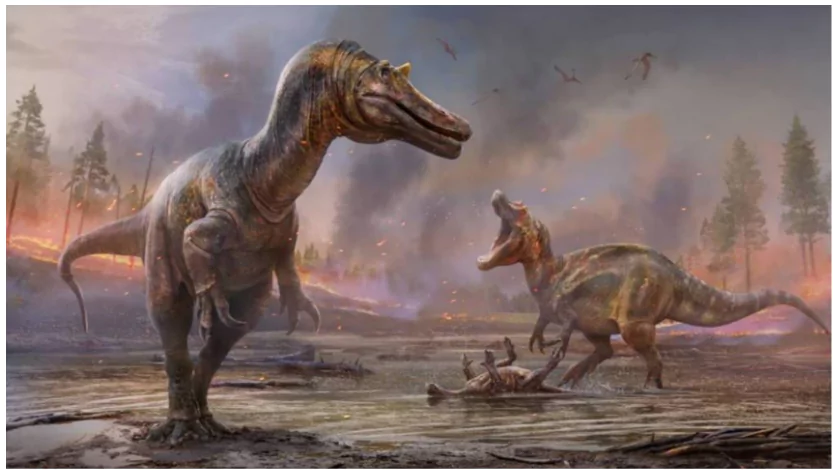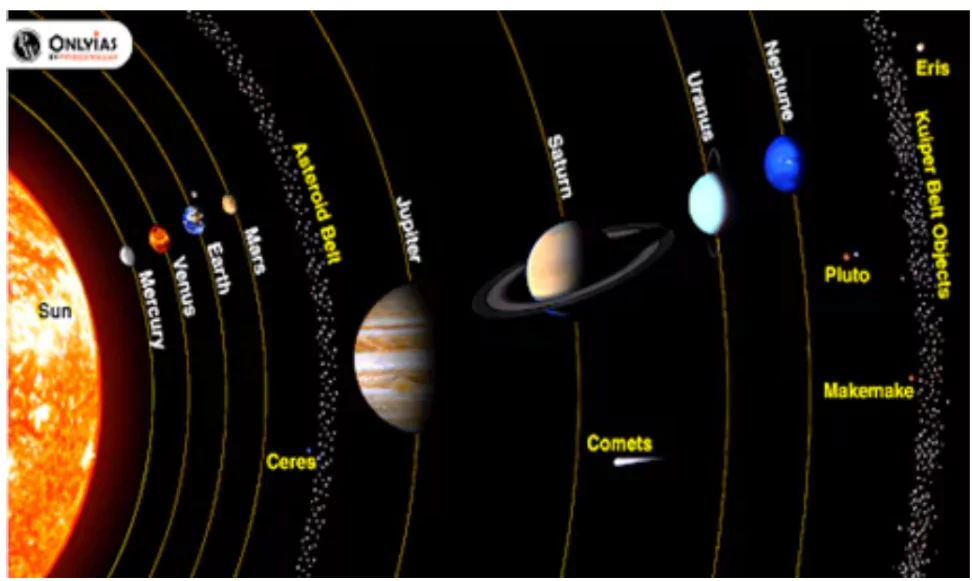Recently, a study published in Journal Science confirmed that the asteroid causing the dinosaur extinction 66 million years ago originated beyond Jupiter’s orbit.
- By analysing sediment samples and ruthenium isotopes, researchers identified the impactor as a carbonaceous asteroid or C-type asteroid, dismissing previous comet theories. These findings deepen the understanding of celestial impacts and Earth’s history.
About the Recent Discovery
This discovery suggests that the mass extinction was the result of a chain of events that began during the very birth of the Solar System.

- Analysis: The researchers analysed samples from five other asteroid impacts dating from 37 million to 470 million years ago, finding that all were S-type, illustrating the rarity of a carbonaceous asteroid strike.
- A New Finding: The findings debunked the earlier theory that a comet, rather than an asteroid, had triggered the Cretaceous–Paleogene extinction event.
- All meteorites falling onto the earth, which are fragments from both C-type and stony S-type asteroids, originate from the asteroid belt. So it appears to be most likely that the (end-Cretaceous) impactor also originates from the asteroid belt.
- Impact Observed: The impact at the end of the Cretaceous Period gouged the Chicxulub crater, 180 km wide and 20 km deep.
-
- The clay layer is rich in metals including iridium, ruthenium, osmium, rhodium, platinum and palladium that are rare on the earth but common in asteroids.
- On Dinosaurs: Dinosaurs had long ruled the land but, aside from their bird lineage, were wiped out following the impact, as were the flying reptiles called pterosaurs, the large marine reptiles and other sea life including many marine plankton species.
- The mammals made it through, allowing these furry critters to eventually dominate the land and setting the stage for our species to arise roughly 300,000 years ago.
Enroll now for UPSC Online Course
- Focus on Ruthenium: Geochemists obtained samples from 3 sites at the Chicxulub crater, and compared with rocks from 8 other asteroid impact sites from the past 3.5 billion years. The focus was on ruthenium – specifically, the ratio of its isotopes present in the clay layer.
- The clay layer is almost entirely made up of ruthenium from the impactor and not the background sediment, and ruthenium shows distinct isotopic compositions between inner and outer solar system materials.
- Ruthenium has seven isotopes, with three especially important in the findings. The ruthenium isotope ratios matched other known carbonaceous asteroids.
- Isotopes are atoms of the same element with slightly different masses because of differing numbers of subatomic particles called neutrons.
- The Ruthenium isotopes in the Chicxulub impactor were a good match for a carbonaceous asteroid from the outer Solar System, rather than a siliceous asteroid from the inner Solar System.
- Ruthenium is extremely rare in Earth rocks, hence samples offer “pure signature” of the celestial body that has collided with Earth.
- Also, the specific ruthenium isotope can help scientists pinpoint exactly where in the Solar System an asteroid came from.
- A Deadly Chain of Events: Computer simulations have shown a number of situations in which an object from the outer Solar System can be pulled out of its orbit to head towards Earth.
-
- A number of possible reasons, such as bumping into other asteroids or gravitational pulls of planets and the Sun, can be behind this.
- Collision with Earth: If an asteroid’s normal orbit is disrupted, a collision with Earth is highly unlikely. A 2021 study found that Earth is likely to collide with large asteroids only once in 250 million years.
- While such a collision is unlikely to take place in humanity’s lifetime, if it does occur, it will be deadly.
- The massive volumes of sulfur, dust and soot that the asteroid-impact threw in the air, partially blocked the Sun, and caused decrease in temperatures on Earth and impaired photosynthesis in plants and phytoplankton.
- This caused massive disruptions in the ecosystem that, in the end, very few creatures could survive.
About Asteroids and their Threat
Asteroids are sometimes also called minor planets, are rocky, airless remnants left over from the early formation of our solar system about 4.6 billion years ago.

- Quantity: According to NASA, the current known asteroid count is 1,113,527.
- Thousands of asteroids enter the Earth’s atmosphere every single day in the form of Meteors and Meteorites but they are not large enough to cause much damage.
- Formation of Asteroid: The Solar System began forming some 4.6 billion years ago, starting as a dense cloud of gas and dust which eventually collapsed to give shape to the celestial bodies that today are Earth’s neighbours.
- High Temperature: During the formation, the temperature in the inner regions of the molecular cloud were too high for volatile chemicals (which can be in the vapour form) to condense.
- Composition: Consequently, asteroids produced there had low levels of volatiles, and became rich in silicate minerals (which make 90% of Earth’s crust).
- Asteroids formed further out became ‘carbonaceous’, containing lots of carbon and volatile chemicals.
- C-type asteroids, among the solar system’s most ancient objects, are the most common asteroid type, followed by stony S-type asteroids and rarer metallic M-type asteroids. Compositional differences among asteroids arise from how far from the sun they formed.
- The C-type asteroids represent leftover building blocks of the outer solar system’s gas and ice planets.
- The S-type asteroids are the primary building blocks of terrestrial planets like the earth in the inner solar system.
- After forming in the outer solar system, the asteroid probably later migrated inward to become part of the main asteroid belt between Mars and Jupiter.
- Orbits: Most asteroids can be found orbiting the Sun between Mars and Jupiter within the main asteroid belt and objects in the Kuiper Belt (a doughnut-shaped region of icy bodies extending far beyond the orbit of Neptune).
- Size Profile: Asteroids range in size from Vesta being the largest at about 329 miles (530 kilometres) in diameter to other objects measuring less than 33 feet (10 metres) across.
- Mass: The total mass of all the asteroids combined is less than that of Earth’s Moon.
- Threat to Earth:
- Cause Mass Extinction: Asteroids are hypothesised to have caused the extinction of dinosaurs
- Chelyabinsk Meteor Explosion: In 2013, a 20-metre wide asteroid exploded about 30 km above a Russian town, releasing energy equivalent to 26 to 33 times released by the atom bomb that detonated over Hiroshima.
- As per the Russian Ministry of Health, while most of this energy was absorbed by the atmosphere, shock waves travelled to the ground, flattened trees, damaged buildings, and injured 1,491 people.
- Shock waves are sound waves. They occur in the atmosphere during explosive events such as during detonations or lightning strikes.
Check Out UPSC CSE Books From PW Store
![]() 19 Aug 2024
19 Aug 2024


